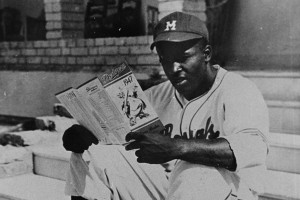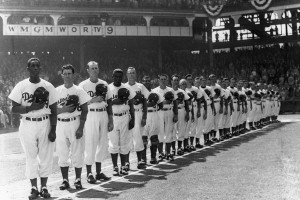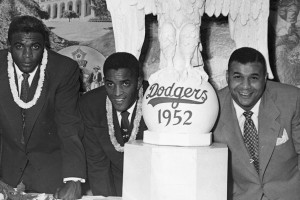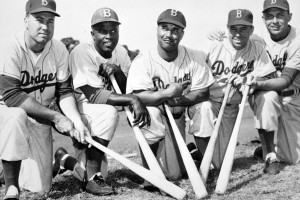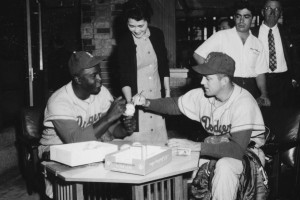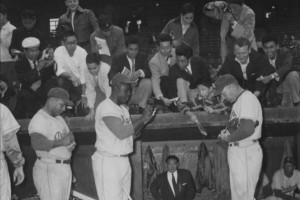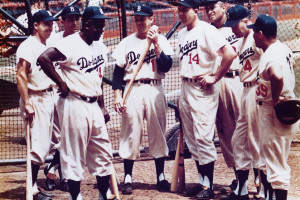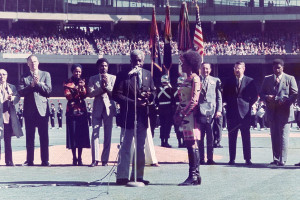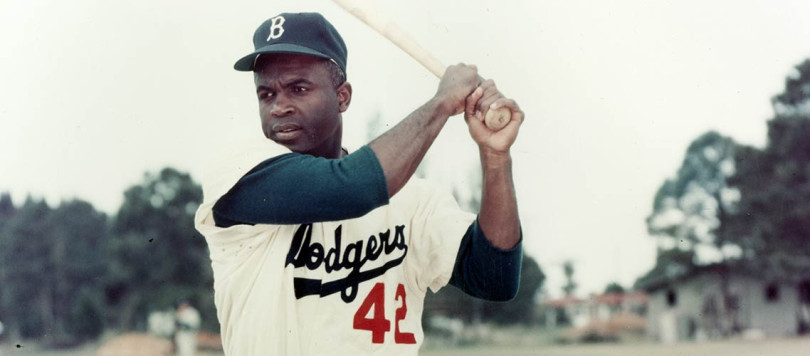
Jackie Robinson, No. 42 at Dodgertown – Vero Beach, Florida. In 1947, Robinson integrated Major League Baseball with the Dodgers. In 1948, when Robinson played at Dodgertown, the site became MLB’s first integrated Spring Training camp in the South in the United States.
Hall of Famers
Jackie Robinson INF 42
- Born:
- Cairo, GA
- Died:
- Stamford, CT
- Years with Dodgers:
- 1947-56
- Inducted into Hall of Fame:
- 1962
The social impact of Jackie Robinson’s inclusion into Major League Baseball in 1947 resonates as one of the civil rights movement’s most significant triumphs. For Robinson, the first African-American to have the opportunity to participate in the major leagues for the Brooklyn Dodgers, it was all about playing the game. But, he was hand-selected by President Branch Rickey and the Dodger organization (including part-owner and Vice President and General Counsel Walter O’Malley) to cross the precipitous color line. Robinson promised Rickey that he would not fight back, other than with his bat and glove, despite what teammates, competitors, fans, umpires, writers, broadcasters and hotel managers might have said or how they tried to bait him into reacting. Robinson agreed to take on this historic civil rights challenge and was uniquely qualified to succeed. When he crossed the white lines at the ballpark, Robinson tried to relax and focus on the game, not the constant catcalls. Off the field, the former UCLA four-sport star would also deal with Southern bigotry; anonymous death threats; racial slurs; sitting in the back of the bus; “no colored” served or housed here signs; and opponents who were out to injure him. Robinson, however, was bound and determined that he would perform to the highest level. That he did. In his debut season, he was named Rookie of the Year, an award which today bears his name, and he became an immediate drawing card. While some just wanted to observe the only Black player in baseball, others were truly enthralled by Robinson’s daring and reckless abandon on the basepaths and in the field. Robinson electrified the ballpark as he stole home 19 times in his illustrious career. In his 10 seasons, Robinson was a six-time N.L. All-Star, he was an integral part of the Dodgers’ 1955 World Championship team, plus five additional N.L. Pennant-winning Dodger teams (1947, 1949, 1952, 1953, and 1956) and he won the N.L. batting title in 1949 with a .342 average. He also won the N.L. MVP Award in 1949.
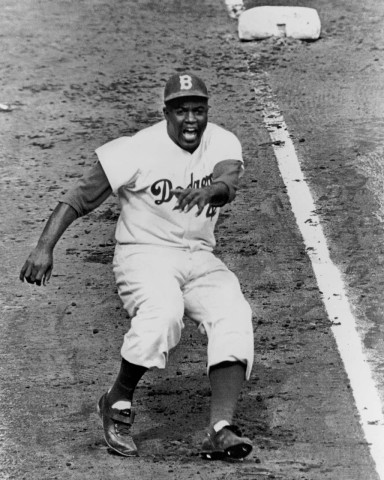
September 30, 1955. Game 3 of the 1955 World Series, 2nd inning. Jackie Robinson decoys the Yankees to think he is trying to steal home after he had done that in Game 1. His moves upset Yankee pitcher Bob Turley enough that the pitcher walked in a run and the Dodgers won Game 3, 8-3 behind Johnny Podres.
When the Dodgers traded an aging Robinson on Dec. 13, 1956 to the New York Giants for Dick Littlefield and $35,000 cash, Robinson balked at playing for any other club, especially the rival Giants, and he vetoed the move by announcing his retirement on Jan. 5, 1957. Because his legs were ailing, Robinson had already intended to retire after the 1956 season to work as an executive for Chock Full O’ Nuts. But, he kept his plans under wraps, selling his retirement story to LOOK magazine which was not released until January 22, 1957.
The versatile Robinson initially played first base for the Dodgers as a rookie, but then moved to second base for the next five years, shifted to third base and finally to the outfield. Robinson was the Dodgers’ highest paid player from 1950-1955.
On March 2, 2005, pioneer Robinson was recognized posthumously by receiving the Congressional Gold Medal during ceremonies in the rotunda of the United States Capitol Building in Washington, D.C. President George W. Bush made the presentation to Robinson family members, including Jackie’s wife Rachel, daughter Sharon and son David. The U.S. Congress has commissioned gold medals as its highest expression of national appreciation for distinguished achievements and contributions. President Bush said of Robinson, “His electricity was unbelievable. This is a guy who inspired little seven-year-olds to dream of wearing ‘42’ and dashing for home in Brooklyn...his story was powerful then, and it is powerful today.”
In 2019, Historic Dodgertown, Vero Beach, Florida, the former spring training site of the Dodgers for 60 years, was re-named the Jackie Robinson Training Complex and controlled by Major League Baseball, which signed a long-term lease agreement with Indian River County. On April 2, 2019, Robinson’s widow Rachel attended the naming ceremonies along with son, David and daughter, Sharon. Historic Dodgertown Chairman Peter O’Malley, who was responsible for the multi-sport complex from 2012 through 2018, also attended.
When Jackie Robinson and the Dodgers played their first game at Dodgertown on March 31, 1948, history was made as it became Major League Baseball’s first integrated spring site in the South. Because of that advancement in American civil rights and more efforts to integrate by the O’Malley family, the site was designated a Florida Heritage Landmark in 2014, while in 2019 it was added to the U.S. Civil Rights Trail, the only sports site on the Trail.
DID YOU KNOW THAT JACKIE ROBINSON...
...RAN 75 yards on a punt return for Pasadena Junior College when they defeated the California Institute of Technology, 12-0, at the Rose Bowl? Jackie also intercepted a pass in the game and threw a touchdown pass. Los Angeles Times, November 23, 1937
...SET a two year college national record in the long jump when he jumped 25 ft., 6 ½ inches at the East-West meet of the California Jaysee League? Jackie was attending school at Pasadena Junior College when he set the record. The previous record holder for the long jump at the junior college was his brother Mack, who had jumped 25 feet, 5 ½ inches for Pasadena Junior College! Charles Curtis, Los Angeles Times, May 8, 1938
...RECEIVED support from citizens of Pasadena for more than $200 to send Jackie to the National Amateur Athletic Track and Field championships in Buffalo, New York so Jackie could compete in the broad jump? Jackie’s teammates at Pasadena Junior College and a local newspaper provided support for the campaign that was led by Charles Paddock, the original “World’s Fastest Human” and a former record holding sprinter. Los Angeles Times, June 26, 1938
...KICKED the extra point conversion after scoring touchdowns for Pasadena Junior College and UCLA? Jackie also returned punts and kickoffs and played running back and quarterback at the two schools. Los Angeles Times, September 17, 1938
...WAS the Southern California junior college Western Conference points leader on his Pasadena Junior College football team? Jackie led the league in touchdowns with eight and kicked nine extra points. Los Angeles Times, November 29, 1938 Jackie would later be named to the first team as quarterback on the All-Southern California Junior College football team. Los Angeles Times, December 22, 1938
...LED his Pasadena Junior College football team to 14 consecutive wins in 1938? Their final game had the junior college players defeating California Institute of Technology 39-6 and Jackie scored two touchdowns. Los Angeles Times, November 24, 1938
...WAS recruited by UCLA to be one of the top football players when he signed a letter of intent in 1939? Frank Finch of the Los Angeles Times wrote “UCLA talent scouts yesterday plucked the juiciest plum of the 1939 crop of college-bound athletes...Acclaimed as the most brilliant ball carrier ever developed in Southland junior college ranks, (Jackie) Robinson is expected to help make Coach Babe Horrell’s (UCLA) Bruins a distinct threat in the 1939 Conference scramble...Robinson was the outstanding individual football drawing card on the Coast last year. The potent (Pasadena Junior College) Bulldog eleven, with Robinson operating at one of the halfback berths, consistently drew from 25,000 to 50,000 spectators to the weekly games played in the Rose Bowl. Ninety-nine percent of those present were there because they wanted to see Robinson scoot. Frank Finch, Los Angeles Times, February 17, 1939
...WAS photographed by the Los Angeles Times so that readers could get an idea of what it would look like if Robinson was running at you? When the photographer showed up for the photos, Robinson said he didn’t know what he would do. Reporter Dick Hyland wrote, “By admitting he did not know what he was going to do to elude tacklers, Jackie Robinson not only proved he was an honest man himself and wanted to fool no one but the tackler...Robinson came booming, all right, with the sideline to one side of him, a flock of theoretical tacklers to his left who forced him to come straight ahead, and before him two real live Bruins who were to nail him in fact—if they could. The camera was on all of it. He (Robinson) flowed—there is no better word for it.” Dick Hyland, Los Angeles Times, October 28, 1939
...WON the basketball scoring championship in the Southern Division of the Pacific Coast Conference with 148 points in the 1940 season for UCLA? Robinson was also named to the first team of the Southern Division All-Star team of the Pacific Coast Conference in basketball. Los Angeles Times, March 3, 1940
...PULLED off one of the exciting football plays of the 1940 college football season? When the UCLA Bruins played Stanford, Jackie was awaiting a punt return. After the Stanford punter kicked the ball, the ball bounced and came to a dead stop on the UCLA 12-yard line. The Stanford defenders looked at the ball and looked at Jackie, standing by the ball. Suddenly, Jackie scooped up the ball and ran up the sideline. Taken by surprise, the Stanford players chased Jackie and he ran 43 yards on the punt return to take the Bruins out of danger from their end zone. Los Angeles Times, November 17, 1940
...GAVE credit to his Bruin teammates for his football success? After a game when Jackie scored three touchdowns, two touchdowns on long runs, he graciously thanked a teammate after the game. “I wanted to congratulate you for winning the old ball game” said Robinson to teammate Ted Forbes. “Why me?” asked Forbes. “Because your blocking made my long runs possible. That’s why. All I did was just run with the ball,” said Jackie. Forbes was a leading blocker on a 75-yard run for a touchdown by Jackie. Paul Lowry, Los Angeles Times, November 17, 1940
...MADE players on other football teams so nervous with his running ability they would refuse to kick the football to him? Jackie was considered to be a very fast runner if he received the football on kick returns and punts to him and opposing coaches knew if Jackie had the ball he could gain many yards. “It was quite apparent that Coach (Howard) Jones (USC) and his lads would much rather hear the echo of the booing chorus that goes up when teams refuse to punt to elusive, unpredictable Jackie Robinson, than to witness the Uclan halfback reeling off untold yards toward pay dirt.” Paul Zimmerman, Los Angeles Times, November 27, 1940
...PLAYED in front of 103,000 football fans in the Los Angeles Memorial Coliseum in the 1939 UCLA-USC game? The two undefeated teams played to a 0-0 tie as neither team could capitalize on scoring opportunities. The tie game meant the USC Trojans would play in the Rose Bowl because USC had two ties but UCLA had three ties. Jackie Robinson did play in the Rose Bowl stadium, but he would not play in the Rose Bowl game on New Year’s Day. Paul Zimmerman, Los Angeles Times, December 10, 1939
...SCORED a touchdown playing for the College All-Star football team against the NFL champion Chicago Bears? Every pre-season in the NFL, the league champion would play a game against the best college players and Jackie was selected to be on the team. Jackie scored a touchdown for the All-Stars, but the Bears won the game 37-13. Jackie received votes for the Most Valuable All-Star Player, but the award went to someone else. Chicago Daily News, August 30, 1941 His touchdown was scored as he caught a long pass from the College All-Star quarterback. Associated Press, August 29, 1941
...PLAYED professional football for a team in Hawaii? Jackie left for Hawaii on September 11, 1941 to play for the Honolulu Polar Bears semi-professional football team in a six-team league in Hawaii. Los Angeles Times, September 12, 1941
...RETURNED to Los Angeles from playing football in Hawaii to play professional football in the Pacific Coast Professional League for the Los Angeles Bulldogs? Other teams in the league were from cities of Hollywood, San Francisco, and San Diego.
...COACHED basketball for a college team? Jackie was an assistant coach at Sam Houston College in Austin, Texas. The president of Sam Houston College, Rev. Karl Downs, married Rachel and Jackie Robinson, and Jackie had visited the college president often when Robinson was in the United States Army at Ft. Hood in Texas. D.C. Clements of Waco, Texas, played on the team Jackie coached. “If you cut a class or anything like that, he would put you off the team or give you some laps. He was a great coach and a great teacher. He was way ahead of his time.” EricEnders.com
...KNEW he would dedicate himself to perform well with the Dodgers? Upon the signing of his first contract with the Dodgers in October, 1945, he told the Baltimore Afro-American newspaper, “I realize the responsibility---not so much to myself as to my people and I won’t let them down. I’ll start swinging as soon as I get to bat.” Baltimore Afro-American, October 27, 1945
...RECEIVED great national attention when he signed his first professional contract for the Dodgers? Roger Treat of the New York Daily News wrote, “Branch Rickey has slapped Jim Crow in the face, broken an unwritten law which has endured since the beginning of organized baseball and opened a new road for several million Americans to start following the creed of America.” Sam Lacy, sportswriter for the Baltimore Afro-American sent a telegram to Branch Rickey that said, “Your action is the first time in the long history of organized baseball that the sport deserves to be called “The National Pastime.” Baltimore Afro-American, October 27, 1945
...PUBLISHED a three part interview with Sam Lacy of the Richmond Afro-American on his attempt to make the Brooklyn Dodger roster for the 1947 season? Richmond Afro-American, March 15, 1947
...PREPARED for the pressure of his first professional season? Jackie, in the first part of a three part interview with the Richmond Afro-American, said “I was the advance guard, so to speak. I was the force that had been chosen to establish a beachhead in hostile territory. I was to test the potency of enemy fire. And as I sat there in the rear of that darkened bus with my eyes closed, I decided to map out the strategy I would use. The jostling of the rickety vehicle wouldn’t let me sleep, so there was plenty of time to think. That’s when it came to me that my cause was sure to be a winning cause. I thought of the various weapons the enemy had used to prove that in the world my race was inferior to all others. One of those weapons was this senseless law which required my wife and me to sit on the back seat of buses in the South. We did it, we still do it, and except for a slight and temporary injury to our pride, nothing really serious comes of it. We suffer no physical harm and their only gain is a false sense of social security. And as I sat there thinking, I tore down each one of the enemy’s anti-racial weapons in much the same way---from his carefully hidden peonage system to the Jim Crow educational pattern which still persist all the way up to the steps of the Capitol in Washington. I can’t help feeling that during the sleepless overnight ride from Pensacola to Sanford (Florida), Jackie Robinson matured! By March 3, when I stepped onto the practice field at Daytona Beach for my initial workout in organized baseball, I was ready for anything. Richmond Afro-American, March 15, 1947
...SURPRISED himself at dinner one night in Havana, Cuba? The Dodgers were playing an exhibition series in Havana and Jackie went to dinner with catcher Roy Campanella. Campanella had played in Mexico and displayed a strong use of the Spanish language. One night, Robinson ordered arroz con pollo from the menu in the Cuban restaurant. Campanella told the second baseman he was ordering chicken and rice and Jackie laughed because he said he had not enjoyed that meal at home. Richmond Afro-American, March 22, 1947
...THANKED fans of the Montreal Royals when the Royals won the 1946 International League Championship? Robinson described the scene. “When, at the close of the series, the Montreal fans rushed from the stands, and lifted me to their shoulders, I know I was the happiest man in the world. I knew I was among a host of warm friends, that nowhere on earth could there breathe a wealthier person than I. This was the crowning glory for me; this was evidence that the brotherhood of man could invade the precincts of organized baseball with nobody suffering from the experience” said Jackie. Richmond Afro-American, March 22, 1947
...PRAISED his wife Rachel for his success? At the 1948 National Urban League and Greater New York Urban League Dinner, Jackie told the dinner audience that Rachel was responsible for his success and “that she really stood by when the going got tough.” Baltimore Afro-American, February 21, 1948
...SPOKE as the announcer for a six-day-a-week radio sports show on station WMCA in New York City? The program was named “The Jackie Robinson Sports Show.” Robinson said the emphasis of the show would be to fight juvenile delinquency. Baltimore Afro-American, October 2, 1948
...WORKED for the Harlem YMCA in New York City with Roy Campanella? The YMCA would start a program named the Jackie Robinson-Roy Campanella Competitive Clubs to promote youths participating in sports. Baltimore Afro-American, November 6, 1948
...PLAYED in exhibition games in Texas with the Dodgers? Games in San Antonio and Beaumont, Texas were sold out on the notice that Robinson would be playing in the games. The newspaper reported that by the time Robinson arrived at the stadium at 10:45 a.m., the line to buy tickets for the night game was two blocks long. One person said, “Anyone would think it was Opening Day at Yankee Stadium.” Baltimore Afro-American, April 2, 1949


